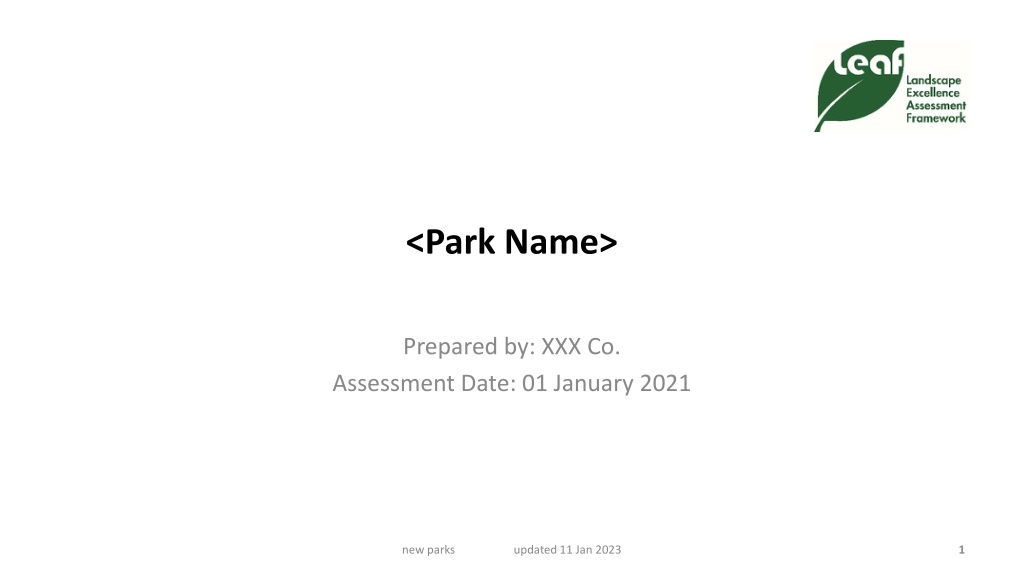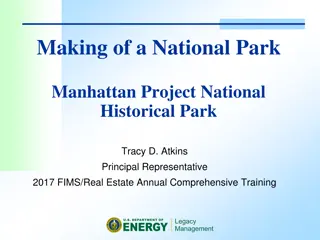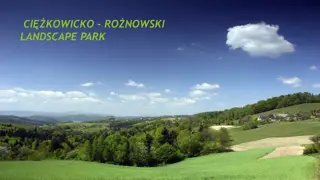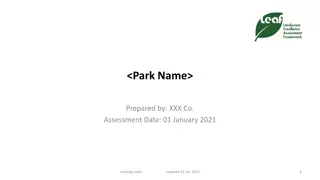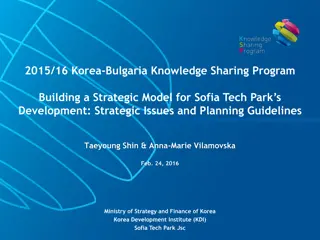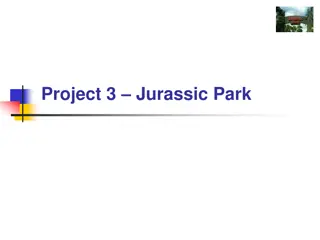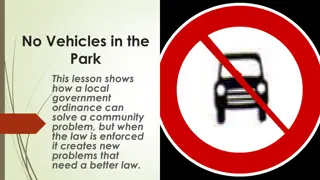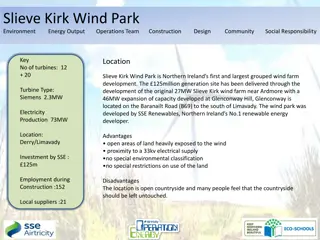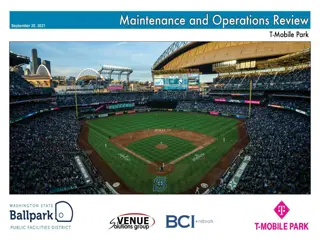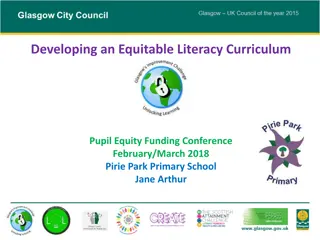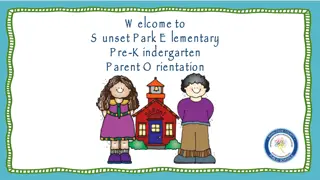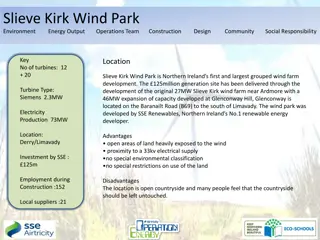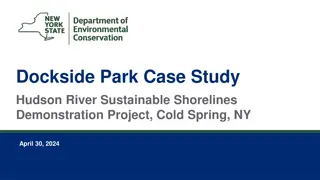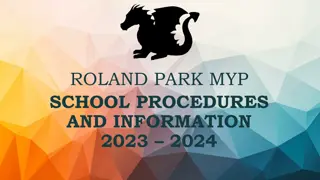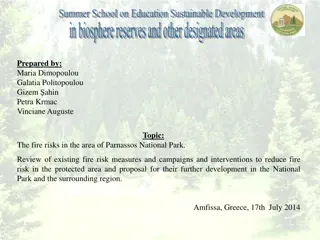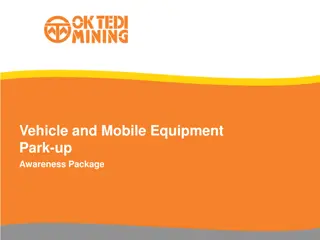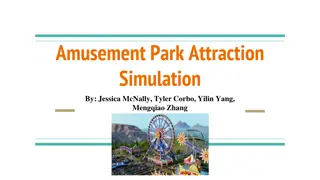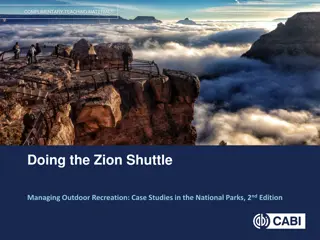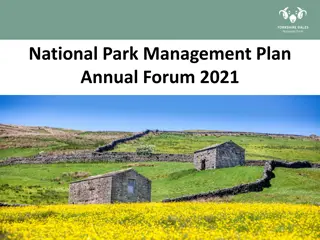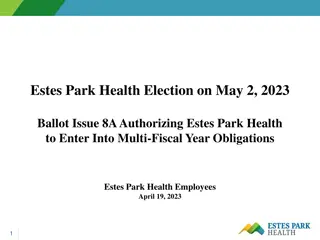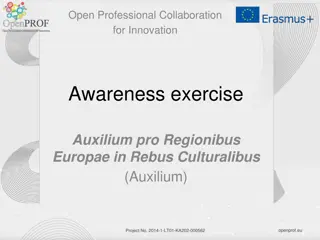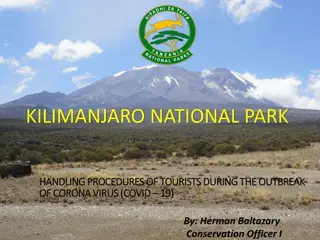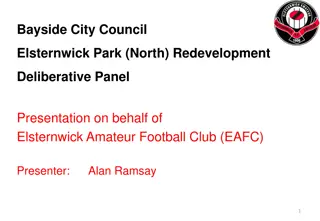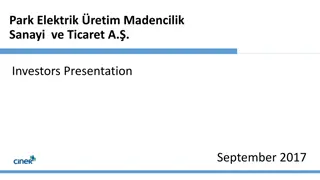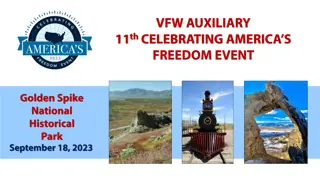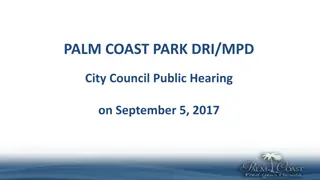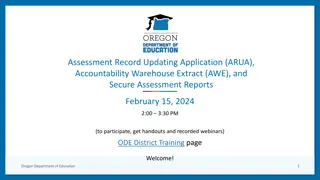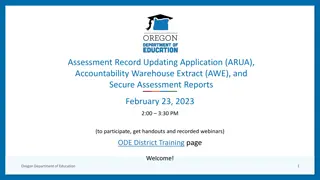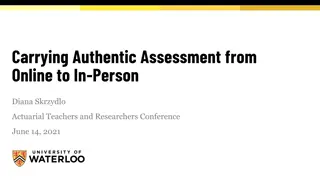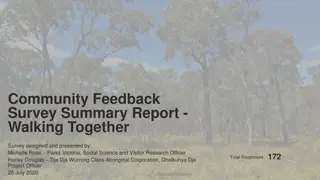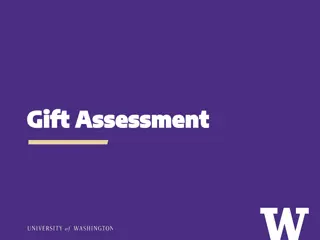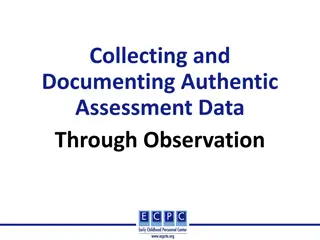Park Assessment and Development Summary
This document presents an assessment of a park's design, landscape, user comfort, and overall features, including considerations for existing elements, biophilic design, and user comfort. It also includes a summary of scores in various criteria related to design, sustainability, community engagement, and more. The assessment aims to provide insights into the park's quality and future development prospects.
Download Presentation

Please find below an Image/Link to download the presentation.
The content on the website is provided AS IS for your information and personal use only. It may not be sold, licensed, or shared on other websites without obtaining consent from the author. Download presentation by click this link. If you encounter any issues during the download, it is possible that the publisher has removed the file from their server.
E N D
Presentation Transcript
<Park Name> Prepared by: XXX Co. Assessment Date: 01 January 2021 new parks updated 11 Jan 2023 1
Project Name: XXX Development Owner: XXX Type: Regional/Nature/Town Park Landscape Architect: XXX Address: XXX Architect: XXX Site Area: XXX Completion Date: XXX new parks updated 11 Jan 2023 2
SCORES SUMMARY TOTAL APPLICABLE SCORE SELF-ASSESSED SCORE ASSESSORS SCORE S/N CRITERIA 1 DESIGN & LANDSCAPE 20 X 2 ACCESSIBILITY 14 X 3 COMMUNITY WELLBEING & ENGAGEMENT 27 X 4 ENVIRONMENTAL SUSTAINABILITY 31 X 5 BIODIVERSITY CONSERVATION 33 X 6 MAINTENANCE 25 X 7 BONUS 5 X TOTAL XXX XXX Certified/Silver/ Gold/Platinum (XX%) new parks updated 11 Jan 2023 3
Part 1: Design & Landscape 1.1 Overall Landscape Concept 1.1a Consideration for existing features Score Assessors Fair Identified existing features e.g. baseline map 1 Fairly Good Retained some existing features or characteristics in overall design 2 Good Integrated existing features in overall design to achieve purposeful objectives 3 Leveraged on and integrated existing features in overall design and with surrounding areas to achieve purposeful objectives Very Good 4 Leveraged on and integrated existing features with surrounding areas creatively to achieve purposeful objectives, with consideration for maintenance Excellent 5 Please include explanations, photos, documentation, statistics, etc. to support self-assessed score for each criteria For documents that are not convenient for including in presentation, please send the separate files You may send additional supporting documents separately, too For criteria that you deem to be not applicable, please also state reasons why new parks updated 11 Jan 2023 4
Part 1: Design & Landscape 1.1 Overall Landscape Concept 1.1b Biophilic elements Score Assessors Fair Incorporated some biophilic elements 1 Good Incorporated biophilic elements moderately 2 Excellent Incorporated biophilic elements extensively and purposefully 3 new parks updated 11 Jan 2023 5
Part 1: Design & Landscape 1.2 User Comfort 1.2a Percentage of paths and open spaces shaded by vegetation in 5 years time Score Assessors <30% 1 30 - 70% 2 >70% 3 new parks updated 11 Jan 2023 6
Part 1: Design & Landscape 1.2 User Comfort 1.2b Thermal comfort Score Assessors Fair Demonstrated some efforts to improve thermal comfort 1 Good Demonstrated moderate efforts to improve thermal comfort 2 Excellent Demonstrated strong efforts to significantly improve thermal comfort 3 new parks updated 11 Jan 2023 7
Part 1: Design & Landscape 1.2 User Comfort 1.2c Resting points Score Assessors Fair Provided some rest points 1 Good Provided sufficient number of rest points across park 2 Excellent Provided sufficient number and variety of shaded rest points at purposeful locations 3 new parks updated 11 Jan 2023 8
Part 1: Design & Landscape 1.3 Unique Park Features 1.3a Unique Features Score Assessors Demonstrated basic efforts to differentiate park e.g. signage, special landscaping intentions to enhance greenery around facilities Fair 1 Good Demonstrated moderate efforts to include some unique features e.g. diversity in trail types 2 Demonstrated great efforts to create strong identity and include unique features e.g. war relics, treetop walk, playground themes Excellent 3 new parks updated 11 Jan 2023 9
Part 1: Design & Landscape TOTAL APPLICABLE SCORE SELF-ASSESSED SCORE ASSESSORS SCORE S/N CRITERIA 1.1 Overall Landscape Concept and Layout 8 X 1.2 User Comfort 9 X 1.3* Unique Park Features 3 X TOTAL 20 X new parks updated 11 Jan 2023 10
Part 2: Community Wellbeing & Engagement 2.1 Wayfinding 2.1a Understanding of wayfinding for users Score Assessors Fair Conducted basic study or analysis e.g. demographics 1 Good Conducted comprehensive study or analysis of various factors that affects wayfinding e.g. behaviour and flow 2 new parks updated 11 Jan 2023 11
Part 2: Community Wellbeing & Engagement 2.1 Wayfinding 2.1b Wayfinding tools at transport nodes nearest to site entrances Score Assessors Low Impact Provided some signage and map boards that are moderately effective in directing visitors 1 Provided various signage and map boards that are clear and user-centric to direct visitors from surrounding transport nodes and at unclear site entrances within 400m radius around park. High Impact 2 new parks updated 11 Jan 2023 12
Part 2: Community Wellbeing & Engagement 2.1 Wayfinding 2.1c Wayfinding from surrounding areas to park Score Assessors Low Impact Some users may experience difficulty in navigating to park from surrounding areas 1 High Impact Most users can navigate to the park easily. Park is well integrated with surrounding areas. 2 new parks updated 11 Jan 2023 13
Part 2: Community Wellbeing & Engagement 2.1 Wayfinding 2.1d Wayfinding in park Score Assessors Low Impact Some areas of park are tough for users to navigate 1 High Impact Most users can effectively navigate at important transport nodes within park 2 new parks updated 11 Jan 2023 14
Part 2: Community Wellbeing & Engagement 2.2 Universal Design Score Assessors Getting to and into park Provided ramps, hand-railings, drop-off points, carpark lots 2.2a 1 Within park, circulation and wayfinding inside park Pathways Informational signage for different user groups Unobstructed viewing areas suitable for wheelchair 2.2b 1 Amenities & facilities UD features in toilets, shelters, seats, auto-doors Facilities for different user groups, e.g. nursing rooms, seats of varying heights, adjacent space for wheelchair 2.2c 1 new parks updated 11 Jan 2023 15
Part 2: Community Wellbeing & Engagement 2.1 Wayfinding 2.1d Design and creative solutions to enhance accessibility for various user groups Score Assessors Demonstrated simple efforts to enhance accessibility E.g. Availability of UD features information online, signages Fair 1 Good Demonstrated efforts to enhance accessibility in design and planning stages 2 Demonstrated holistic approach in planning and design of UD features, including facilities, to enhance accessibility, complementary with overall landscapes and design aesthetics. E.g. Inclusive playgrounds, special routes for different user groups Excellent 3 new parks updated 11 Jan 2023 16
PART 2: COMMUNITY WELLBEING AND ENGAGEMENT TOTAL APPLICABLE SCORE SELF-ASSESSED SCORE ASSESSORS SCORE S/N CRITERIA 8 X 2.1 Wayfinding 2.2* Universal Design 6 X TOTAL 14 X new parks updated 11 Jan 2023 17
Part 3: Community Wellbeing & Engagement 3.1 Facilities & Amenities 3.1a Understanding of users' usage patterns Score Assessors Fair Conducted basic study or understanding of user groups 1 Conducted comprehensive study or analysis conducted for various factors E.g. user needs, experience, behaviour 2 Good new parks updated 11 Jan 2023 18
Part 3: Community Wellbeing & Engagement 3.1 Facilities & Amenities 3.1b Provision of amenities and facilities Score Assessors Fair Provided range of amenities and facilities available that are suitable for some users 1 Good Provided range of amenities and facilities available that are suitable for most users 2 Provided comprehensive range of amenities and facilities at appropriate locations that support needs of various user groups Excellent 3 new parks updated 11 Jan 2023 19
Part 3: Community Wellbeing & Engagement 3.1 Facilities & Amenities 3.1c Design of facilities & amenities Score Assessors Fair Design are user-centric for some user groups 1 Good Design are user-centric for most user groups 2 Design are user-centric, incorporates biophilic design elements to encourage wellbeing, encourages social interaction between users Excellent 3 new parks updated 11 Jan 2023 20
Part 3: Community Wellbeing & Engagement 3.2 Lighting 3.2a Provision of outdoor lighting Score Assessors Fair Main circulation pathways are well-lit 1 Good Majority of circulation paths, facilities and amenities are well-lit 2 Excellent Majority or all of park are well-lit and meet recommendations, where possible 3 3.2b Lighting design and strategies Score Assessors Fair Demonstrated efforts to enhance lighting design and usage 1 Implemented effective lighting strategies to achieve purposeful objectives e.g. wayfinding, impact on biodiversity, integrate with surrounding landscape Good 2 new parks updated 11 Jan 2023 21
Part 3: Community Wellbeing & Engagement 3.3 Toilets 3.3a Provision of toilets Score Assessors Fair Provided some toilets, may not be sufficient for volume of visitors and size of park 1 Good Provided sufficient toilets for volume of visitors and size of park, equipped with basic amenities 2 Provided sufficient toilets equipped with comprehensive amenities suited for park user groups. e.g. child seats, wheelchair and child-friendly wash basins, shower stalls, bike stand, vending machines, drinking fountain Excellent 3 new parks updated 11 Jan 2023 22
Part 3: Community Wellbeing & Engagement 3.3 Toilets 3.3b Design and placement of toilet facilities Score Assessors Fair Toilets are relatively accessible and have basic design features 1 Good Toilets are accessible, well-ventilated and have basic design features 2 Excellent Toilets are accessible, well-ventilated with good user-centric signage, designed with various natural elements 3 new parks updated 11 Jan 2023 23
Part 3: Community Wellbeing & Engagement 3.4 Community Engagement 3.4a Community engagement in park creation process Score Assessors Fair Ad-hoc engagement of users or community in park creation process e.g. mural painting, tree planting 1 Good Engaged users in early phases e.g. Public consultation at planning or design stage 2 Excellent Engaged various stakeholders from early phases through to park completion e.g. school partnerships 3 new parks updated 11 Jan 2023 24
Part 3: Community Wellbeing & Engagement 3.4 Community Engagement 3.4b Community engagement and active stewardship Score Assessors Fair Provided basic engagement plans 1 Good Provided comprehensive engagement plans of <3years with a significant group through variety of ways or in-depth methods. 2 Excellent Provided comprehensive long-term engagement plans of >3 years with different groups, through variety of methods 3 new parks updated 11 Jan 2023 25
Part 3: Community Wellbeing & Engagement 3.4 Community Engagement 3.4c Opportunities for informal and formal social interaction and cultural events Score Assessors Fair Provided spaces for opportunities for social interaction and/or events 1 Good Designed facilities to maximise and encourage social interaction and formal events 2 new parks updated 11 Jan 2023 26
Part 3: Environmental Sustainability TOTAL APPLICABLE SCORE SELF-ASSESSED SCORE ASSESSORS SCORE S/N CRITERIA 3.1 Facilities & Amenities 8 X 3.2* Lighting 5 X 3.3* Toilets 6 X 3.4* Community Engagement 8 X TOTAL 27 X new parks updated 11 Jan 2023 27
Part 4: Environmental Sustainability 4.1 Management of Resources 4.1a Percentage of horticultural waste recycled Score Assessors >10% to 30% 1 >30% to 70% 2 >70% 3 4.1b On-site recycling of horticultural waste Score Assessors Fair Recycles some horticultural waste on-site 1 Good Recycles significant amount of horticultural waste on-site 2 4.1c Use of non-potable water used for irrigation Score Assessors Uses 10 to <50% non-potable water for irrigation 1 Uses 50% non-potable water for irrigation 2 Uses 50% non-potable water for irrigation, and requires minimal irrigation for plants to thrive 3 new parks updated 11 Jan 2023 28
Part 4: Environmental Sustainability 4.1 Management of Resources 4.1d Active energy efficiency Score Assessors Low impact Demonstrated some efforts to incorporate energy-efficient features or use renewable energy 1 Moderate impact Demonstrated moderate efforts to incorporate energy-efficient features or use renewable energy 2 Demonstrated strong efforts to incorporate energy-efficient features or use renewable energy, significantly reduced energy usage High Impact 3 new parks updated 11 Jan 2023 29
Part 4: Environmental Sustainability 4.1 Management of Resources 4.1e Use of natural daylight and cross ventilation Score Assessors Fair Demonstrated some effort to incorporate natural daylighting and ventilation 1 Good Demonstrated moderate efforts to incorporate use of natural daylighting and ventilation 2 Demonstrated strong efforts to use natural daylighting and ventilation effectively, significantly reduced need for artificial lighting and cooling equipment for facilities and amenities Excellent 3 new parks updated 11 Jan 2023 30
Part 4: Environmental Sustainability 4.1 Management of Resources 4.1f Water efficiency Score Assessors Demonstrated basic efforts to monitor water consumption and reduce water usage e.g. use of water-efficient taps Fair 1 Demonstrated moderate efforts to monitor water consumption and implementations to reduce water usage Good 2 Demonstrated strong efforts to monitor water consumption and implementations to significantly reduce water usage Excellent 3 new parks updated 11 Jan 2023 31
Part 4: Environmental Sustainability 4.2 Source of Materials 4.2a Score Assessors Acquired plants from nurseries under NParks Nursery Accreditation Scheme (NAS) 1 new parks updated 11 Jan 2023 32
Part 4: Environmental Sustainability 4.2 Source of Materials 4.2b Sustainable source for construction and landscaping materials Score Assessors <10% of materials of applicable usage 1 10 to 50% of materials of applicable usage 2 >50% of materials of applicable usage 3 4.2c Exportation of topsoil fill off site Score Assessors Fair Some efforts to minimise exportation 1 Good Strong efforts to minimise exportation 2 new parks updated 11 Jan 2023 33
Part 4: Environmental Sustainability 4.3 Stormwater Management 4.3a Treatment of run-off through natural hydrological features Score Assessors 10% of total runoff of catchment area conveyed through features 1 11% to 35% of total runoff of catchment area conveyed through features 2 >35% of total runoff of catchment area conveyed through features 3 4.3b Rainwater harvesting Score Assessors Fair Has basic rainwater harvesting features 1 Good 2 Integrated rainwater harvesting with natural hydrological features and re-using of harvested water Excellent 3 new parks updated 11 Jan 2023 34
Part 4: Environmental Sustainability 4.3 Stormwater Management 4.3c Design of natural hydrological features Score Assessors Low impact Simple enhancements 1 High Impact Use of creative strategies for space-efficiency, maintenance needs, multi-functionality 2 new parks updated 11 Jan 2023 35
Part 4: Environmental Sustainability TOTAL APPLICABLE SCORE SELF-ASSESSED SCORE ASSESSORS SCORE S/N CRITERIA 17 X 4.1 Management of Resources 4.2 Source of Materials 6 X 4.3* Stormwater Management 8 X TOTAL 31 X new parks updated 11 Jan 2023 36
Part 5: Biodiversity Conservation 5.1 Native Plants 5.1a Number of planted species that are native to Southeast Asia region Score Assessors 20% to <40% 1 40% to 60% 2 >60% 3 5.1b Quantity of planted species that are native to Southeast Asia region Score Assessors 10 to 30% 1 >30% to 70% 2 >70% 3 5.1c Efforts to manage exotic invasive species Score Assessors Demonstrated simple efforts to manage spread of exotic species Fair 1 Demonstrated strong efforts to monitor and document exotic urban biodiversity, conduct impact assessments, and manage spread of exotic species Good 2 new parks updated 11 Jan 2023 37
Part 5: Biodiversity Conservation 5.2 Tree Retention 5.2a Trees inventory Score Assessors Fair Provided simple list of trees 1 Provided comprehensive list of tree flora species, quantity and provenance, with assessment of trees retained and removed with reasons for measures applied Good 2 5.2b Percentage of retained existing mature trees Score Assessors >10% to 20% 1 30% to <60% 2 > 60% 3 new parks updated 11 Jan 2023 38
Part 5: Biodiversity Conservation 5.2 Tree Retention 5.2c Quality and design incorporation of mature or existing trees Score Assessors Fair Simple incorporation of retained trees 1 Good Trees retained are healthy, incorporated with good design 2 new parks updated 11 Jan 2023 39
Part 5: Biodiversity Conservation 5.3 Biodiversity-sensitive Planting & Design 5.3a Understanding of existing habitats, ecological processes and nearby environments Score Assessors Fair Identified site conditions and features 1 Identified and analysed ecological networks beyond site, connections to off- site habitats, wildlife species expected to utilise connection Good 2 new parks updated 11 Jan 2023 40
Part 5: Biodiversity Conservation 5.3 Biodiversity-sensitive Planting & Design 5.3b Habitat creation through planting design Score Assessors Created themed trails and plots based on existing planting. e.g. butterfly-attracting shrubs, bee trails Fair 1 Enhanced existing habitats or created new habitats to increase flora and fauna diversity. e.g. grasslands, riverine, dragonfly ponds Good 2 Used holistic design that considers existing surrounding habitats, and emulated native landscapes to preserve or increase biodiversity e.g. varying canopy heights, increasing food plants variety, etc. Excellent 3 new parks updated 11 Jan 2023 41
Part 5: Biodiversity Conservation 5.3 Biodiversity-sensitive Planting & Design 5.3c Features to optimise linkages and connectivity between habitats and landscape areas Score Assessors Fair Demonstrated simple efforts to connect different areas and/or habitats in park 1 Good Demonstrated strong efforts to connect to habitats and ecological networks beyond park s boundary 2 Excellent Demonstrated strong efforts to connect to habitats and ecological networks beyond park s boundary 3 new parks updated 11 Jan 2023 42
Part 5: Biodiversity Conservation 5.3 Biodiversity-sensitive Planting & Design 5.3d Efforts to manage human-wildlife interaction Score Assessors Fair Identified potential human-wildlife interactions, with evidence or studies 1 Good Demonstrated efforts to manage human-wildlife interactions 2 new parks updated 11 Jan 2023 43
Part 5: Biodiversity Conservation 5.4 Conservation of Habitats, Ecological Processes & Wildlife 5.4a Biodiversity impact assessment Score Assessors Fair Provided list of flora and fauna species, numbers and provenance in existing site 1 Conducted BIA, with inventory of flora and fauna species, numbers and provenance in existing site, and impact assessment for planned park concept and design on biodiversity Good 2 new parks updated 11 Jan 2023 44
Part 5: Biodiversity Conservation 5.4 Conservation of Habitats, Ecological Processes & Wildlife 5.4b Conservation management plan Score Assessors Fair Provided simple management plans for identified key flora and fauna 1 Provided management plans for identified key flora and fauna with clear objectives, measures, monitoring protocols Good 2 Provided holistic long-term management plan with clear objectives and measures, monitoring efforts with methodology, protocols and feedback channels for continual improvements. Excellent 3 new parks updated 11 Jan 2023 45
Part 5: Biodiversity Conservation 5.4 Conservation of Habitats, Ecological Processes & Wildlife 5.4cConstruction environment management plan to mitigate impacts on wildlife or habitat during development Score Assessors Fair Demonstrated some efforts to manage impacts during park development 1 Good Demonstrated moderate efforts to manage impacts during park development 2 Excellent Demonstrated holistic management to mitigate potential impacts throughout park development, from design to construction 3 new parks updated 11 Jan 2023 46
Part 5: Biodiversity Conservation TOTAL APPLICABLE SCORE SELF-ASSESSED SCORE ASSESSORS SCORE S/N CRITERIA 8 X 5.1 Native Plants 5.2 Tree Retention 7 X 5.3 Biodiversity-sensitive Planting & Design 10 X 5.4* Conservation of habitats, ecological processes & wildlife 8 X TOTAL 33 X new parks updated 11 Jan 2023 47
Part 6: Maintenance 6.1 Design for Maintainability 6.1a Plant species selection and placement Score Assessors Requires high frequency of softscape maintenance due to placement and choice of plant species Low Impact 1 Moderate Impact Requires moderate frequency of softscape maintenance due to placement and choice of plant species 2 Requires minimal softscape maintenance across different weather conditions due to placement and choice of plant species High Impact 3 new parks updated 11 Jan 2023 48
Part 6: Maintenance 6.1 Design for Landscape Maintainability 6.1b Hardscape elements Score Assessors Low Impact Requires high frequency of hardscape maintenance due to choice or design of hardscape elements 1 Moderate Impact Requires moderate frequency of hardscape maintenance due to choice or design of hardscape elements 2 High Impact Requires minimal hardscape maintenance due to choice or design of hardscape elements 3 new parks updated 11 Jan 2023 49
Part 6: Maintenance 6.1 Design for Landscape Maintainability 6.1c Ease of landscape maintenance access Score Assessors Fair <50% of landscaped areas can be easily accessed for inspection and maintenance 1 Good 50 to 80% of landscaped areas can be easily accessed for inspection and maintenance 2 Excellent >80% of landscaped areas can be easily accessed for inspection and maintenance 3 new parks updated 11 Jan 2023 50
